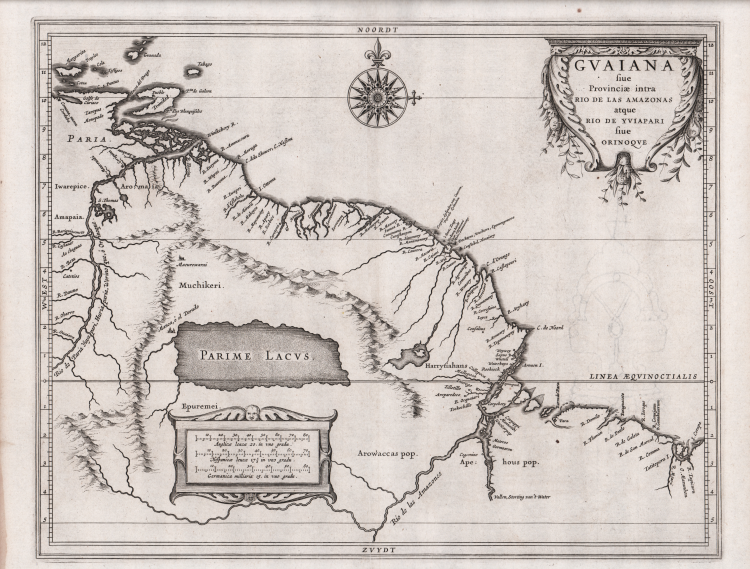




| Reference: | S44867 |
| Author | Johannes de Laet |
| Year: | 1630 ca. |
| Zone: | Guianas |
| Printed: | Leyden |
| Measures: | 360 x 285 mm |



| Reference: | S44867 |
| Author | Johannes de Laet |
| Year: | 1630 ca. |
| Zone: | Guianas |
| Printed: | Leyden |
| Measures: | 360 x 285 mm |
The map covers part of the South American coast from the island of Trinidad to just beyond the mouth of the Amazon River, between the present-day countries of Venezuela and Brazil. Place names are relegated to various geographical features, indigenous villages and European coastal outposts, while topography is pictorially depicted.
The map was published in Leiden in 1630 as part of Johannes de Laet's Nieuwe Wereldt often Beschrijvinghe van West-Indien (Description of the West Indies ). The work was originally published in 1625 and contained ten maps; this is the slightly updated version that contained fourteen maps and 100 more pages of text, reflecting the growing interest of the Dutch in the New World.
Described by Philip Burden as "probably the finest description of the Americas published during the seventeenth century," the maps in de Laet's work were based directly on the cartography of Hessel Gerritsz, an engraver's apprentice to W. J. Blaeu before starting his own business. He was then appointed cartographer to the Dutch East India Company and later held the same position in the newly formed West India Company. Although Gerritsz actually visited the area during his trip to South America and the West Indies undertaken in 1628, this map obviously lacks first-hand knowledge, except along the coast. The interior is dominated by the huge lake (Parime Lacus) with the legendary city of El Dorado (Manoa, or el Dorado) on its shores. Several expeditions were undertaken in the late 16th and early 17th centuries to find this legendary city of gold, and although they contributed significantly to the mapping of the region, they were all ultimately unsuccessful.
Johannes de Laet used meticulous research and contemporary sources to compile his geographical data. As director of the newly formed Dutch West India Company, he also made use of the latest information from private correspondence, manuscripts, and other company secrets when compiling the maps. For this map he appears to have acquired information from English surveys of the Amazon estuary through the English cartographer Gabriel Tatton, who at times during his career worked for Dutch publishers. De Laet also corresponded with Sir Henry Spelman, treasurer of the English Guiana Company.
The map is beautifully engraved with decorative cartouches of the title and distance scale and a large compass rose.
Johannes de Laet(1581 - 1649
Johannes de Laet(1581 - 1649